Introduction
E-commerce has transformed the way consumers access goods and services. What was once a convenience-driven model has evolved into a platform where values, ethics, and environmental responsibility play an increasingly vital role. Today’s shoppers are not only concerned about quality and price; they are also evaluating how companies impact the planet and society. This shift has led to the rise of sustainable practices in modern e-commerce—an approach that prioritizes eco-friendly operations, ethical sourcing, and responsible consumer engagement.
The Rise of Sustainability in Online Retail
Over the past decade, sustainability has become a cornerstone of business strategy for many e-commerce brands. Driven by growing environmental concerns, increasing consumer awareness, and government regulations, companies are integrating sustainable practices into every aspect of their operations.

Factors contributing to this shift include:
-
Climate Change Awareness – Consumers are conscious of how production, packaging, and delivery affect carbon emissions.
-
Ethical Consumerism – People are increasingly choosing brands that align with their values.
-
Corporate Responsibility – Businesses are expected to demonstrate genuine efforts toward environmental protection and social good.
The e-commerce sector is uniquely positioned to lead this charge, given its ability to innovate and quickly adapt to new technologies.
Eco-Friendly Packaging Solutions
One of the most visible changes in e-commerce is the move toward eco-friendly packaging. Traditional packaging—often plastic-heavy—has a devastating impact on the environment, contributing to pollution and landfill waste.

Innovations in Sustainable Packaging
-
Biodegradable Materials – Using packaging that naturally decomposes, reducing long-term waste.
-
Recyclable Boxes & Bags – Encouraging a circular economy where materials are reused.
-
Minimalist Packaging – Cutting down on unnecessary wrapping and fillers to reduce waste and shipping costs.
Impact on Consumer Perception
Brands embracing sustainable packaging not only reduce their environmental footprint but also strengthen consumer trust. Studies show that shoppers prefer brands that demonstrate environmental consciousness through visible actions.
Energy-Efficient Operations
Sustainable e-commerce goes beyond packaging; it extends to how companies run their operations. Warehouses, fulfillment centers, and even websites consume energy. Optimizing these areas is crucial for reducing carbon emissions.

Key Strategies for Energy Efficiency
-
Green Warehouses – Utilizing solar panels, energy-efficient lighting, and temperature control systems.
-
Eco-Friendly Data Centers – Hosting websites on servers powered by renewable energy sources.
-
Smart Logistics – Route optimization for delivery vehicles to minimize fuel usage.
These changes may require investment upfront, but they lead to long-term savings and improved brand reputation.
Sustainable Product Sourcing
Sourcing practices are a critical component of a brand’s sustainability profile. Ethical and eco-friendly sourcing ensures that products are made responsibly—protecting the environment and supporting fair labor conditions.

Practices Leading the Change
-
Fair Trade Partnerships – Supporting suppliers that provide fair wages and safe working conditions.
-
Local Sourcing – Reducing transportation emissions by sourcing products closer to home.
-
Use of Recycled or Renewable Materials – Incorporating materials that minimize environmental impact.
E-commerce companies adopting these methods often highlight transparency, providing details about sourcing origins and production methods.
The Role of Technology in Sustainable E-Commerce
Technology is a powerful driver of sustainability, helping brands monitor their impact and innovate toward greener solutions.

Digital Tools and Their Impact
-
AI-Powered Inventory Management – Reduces overproduction and waste by predicting demand accurately.
-
Carbon Tracking Software – Allows companies to measure and report emissions across supply chains.
-
Augmented Reality (AR) Previews – Helps consumers visualize products before ordering, reducing return rates and associated shipping emissions.
By leveraging advanced technology, businesses can balance profitability with environmental responsibility.
Consumer Behavior and Sustainability
Modern consumers are not passive participants; they are active drivers of sustainability. Their preferences are shaping how companies operate.

Changing Expectations
-
Transparency Matters – Customers want to know the environmental and social impact of their orders.
-
Preference for Green Brands – Many shoppers select businesses committed to eco-friendly practices.
-
Willingness to Pay More – Studies indicate that consumers are open to slightly higher prices for products with a proven sustainability advantage.
E-commerce brands must adapt to this evolving mindset by offering clear information about their environmental initiatives.
Challenges in Implementing Sustainable Practices

While the shift toward sustainability offers immense benefits, it comes with challenges:
-
Higher Initial Costs – Eco-friendly materials and energy-efficient systems often require significant investment.
-
Supply Chain Complexity – Ensuring ethical and sustainable sourcing can be difficult across global networks.
-
Balancing Profitability with Responsibility – Brands must find a way to remain competitive while adopting greener solutions.
Addressing these challenges requires long-term planning, innovation, and a willingness to adapt.
Future of Sustainable E-Commerce
Sustainable practices are not a temporary trend; they represent the future of e-commerce. In the coming years, we can expect:

-
Stricter Environmental Regulations – Encouraging businesses to reduce carbon footprints.
-
Increased Use of Renewable Energy – Powering logistics, warehouses, and digital infrastructure.
-
Circular Economy Models – Encouraging product reuse, recycling, and repair to reduce waste.
-
Collaborative Industry Efforts – Brands working together to establish eco-friendly standards.
These developments will not only help the planet but also redefine how e-commerce connects with its audience.
Conclusion
Sustainability is reshaping modern e-commerce from the ground up—impacting everything from packaging to sourcing, logistics to technology. For USA-based e-commerce businesses, embracing eco-friendly practices is no longer optional; it is essential for long-term growth and consumer trust. By prioritizing responsible operations, brands can align with the values of today’s conscious shoppers and contribute to a more sustainable future.